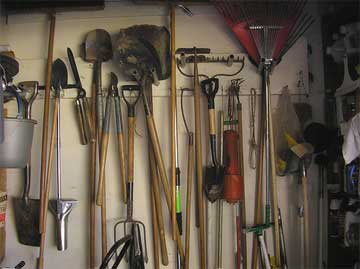
You can’t garden effectively without the proper hand tools. Yet when it comes to the selection of necessary tools the beginner is often at a loss to choose from the endless array of gadgets, accessories and “time-savers” that confront him.
With little more than enthusiasm as a guide he is led into buying tools which, for the most part, have a rather limited use.
Consider The Job And Your Capacity
The best yardstick to apply to garden tools is to first consider the extent of the garden operation, then fit the tools not only to these operations but also to one’s capacity.
Don’t invest in heavy tools if the general scheme doesn’t call for them or if you are unable to handle them.
Choose “Multi-Task Tools”
The next consideration is to choose tools that, where possible, will perform more than one task. Gardening is a true craft and has tools basic to its best performance.
It is among these basic tools, which have changed little over the years, that you will find those that are most serviceable.
Tools of the soil are basic to all gardening.
Foremost among these are a spade and a spading or digging fork. The modern spade is a well-balanced tool ranging in size from the bantamweight for ladies up to the heavy nursery tool weighing over 5 pounds.
In between is the light steel tool with a straight 12-inch blade that is ideal for general garden work. Also popular among gardeners is the 10-inch “Floral;” this has a curved blade.
Either of these is useful for digging around trees and shrubs, transplanting, turning over soil, trenching, root pruning, and covering large seeds, bulbs and roots.
The straight-bladed spade can be used to skim off young weeds, cut sod, trim lawn edges and scatter lawn fertilizer, lime, compost or topdressing.
The digging fork, also obtainable in the ladies’ pattern, comes in two styles – the English and American.
In the latter the tines are diamond-shaped and slightly curved to give “lift,” and in the former they are straight, flat and spread wider at the points, really a tool for digging heavy soil.
You will find the American model easier to handle, but either is ideal for digging heavy or stony soil, especially in the spring.
When it must be broken up to a goodly depth for seeding or planting. The fork can also be used for rough leveling, lifting perennials or digging in fertilizer or organic matter, especially around trees and shrubs.
It is good for lifting gladiolus, dahlias and other bulbous plants with a minimum of slicing, and for loosening compact surfaces of soil or sod for aeration and to destroy weeds.



{ 0 comments… add one now }
You must log in to post a comment.